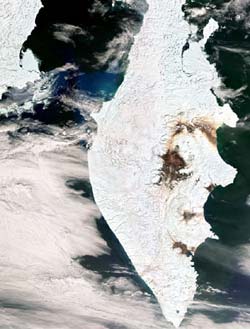Erupting volcano casts shadow on Russian peninsula

This reduced resolution Medium Resolution Imaging Spectrometer (MERIS) image was acquired 11 May 2004 and shows the Kamchatka Peninsula in Russia’s Far East. The erupting Shiveluch volcano is located towards the right of the peninsula about two thirds of the way up - around it is a circular band of dark ash from the eruption visible over snow. <br> <br>Credits: ESA 2004
The most northerly active volcano on Russia’s Kamchatka Peninsula is once again erupting, dusting the surrounding snow-white landscape with a wide expanse of dark ash that is visible from 800 km away in space.
This image of the Kamchatka Peninsula on Russia’s East Coast was acquired on 11 May 2004 by the Medium Resolution Imaging Spectrometer (MERIS) instrument on ESA’s Envisat satellite in reduced resolution mode.
Two thirds of the way up the Peninsula can be seen a roughly circular band of ash, and at the high point of this band is located the steep-sided 3283-metre-high Shiveluch stratovolcano. An aerial cloud of steam and possibly ash originating from the peak is also faintly visible against the ocean to the east of the Peninsula.
Part of the volcanic ’Ring of Fire’ chain located around the Pacific, Shiveluch – also known as Sheveluch – last erupted in 2001. After a two-year lull volcanic activity began again at the start of this year, and on 9 May the volcano underwent an explosive eruption, propelling ash and volcanic gases into the atmosphere up to eight km above sea level.
The locally-based Kamchatkan Volcanic Eruptions Response Team has observed a lava dome growing in the crater and warn that another explosive eruption could be due at any time. Strong volcanic tremors and surface earthquakes have been detected, while heavy mudslides from Shiveluch have also blocked roads in the area.
Media Contact
More Information:
http://www.esa.int/esaSA/SEMQOSGHZTD_earth_0.htmlAll latest news from the category: Earth Sciences
Earth Sciences (also referred to as Geosciences), which deals with basic issues surrounding our planet, plays a vital role in the area of energy and raw materials supply.
Earth Sciences comprises subjects such as geology, geography, geological informatics, paleontology, mineralogy, petrography, crystallography, geophysics, geodesy, glaciology, cartography, photogrammetry, meteorology and seismology, early-warning systems, earthquake research and polar research.
Newest articles

Properties of new materials for microchips
… can now be measured well. Reseachers of Delft University of Technology demonstrated measuring performance properties of ultrathin silicon membranes. Making ever smaller and more powerful chips requires new ultrathin…

Floating solar’s potential
… to support sustainable development by addressing climate, water, and energy goals holistically. A new study published this week in Nature Energy raises the potential for floating solar photovoltaics (FPV)…

Skyrmions move at record speeds
… a step towards the computing of the future. An international research team led by scientists from the CNRS1 has discovered that the magnetic nanobubbles2 known as skyrmions can be…




















